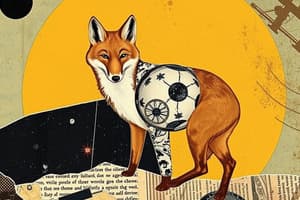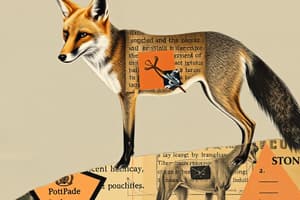Podcast
Questions and Answers
What color is the stone depicted in the image?
What color is the stone depicted in the image?
- Blue
- Brown
- Green
- Gray (correct)
What facial features does the stone have?
What facial features does the stone have?
- Curved eyes and a smile (correct)
- Straight eyes and a frown
- Angled eyes and a grimace
- Round eyes and an angry expression
Which of the following statements is true regarding the stone?
Which of the following statements is true regarding the stone?
- It has multiple distinct features.
- It represents a musical instrument.
- It is an irregular shape.
- It has a simple happy face. (correct)
What is the overall shape of the stone as described?
What is the overall shape of the stone as described?
What distinguishes the stone from other objects?
What distinguishes the stone from other objects?
What is an expedition primarily characterized by?
What is an expedition primarily characterized by?
Samurai were known for being skilled warriors and were often disloyal to their daimyos.
Samurai were known for being skilled warriors and were often disloyal to their daimyos.
Who were the strong warlords and landlords of Japan during the feudal period?
Who were the strong warlords and landlords of Japan during the feudal period?
A ______________ is a conqueror, particularly known for the Spanish conquests in the Americas during the 16th century.
A ______________ is a conqueror, particularly known for the Spanish conquests in the Americas during the 16th century.
Match the following terms to their correct definitions:
Match the following terms to their correct definitions:
What was one of the consequences of the arrival of the Portuguese in Warring States Japan?
What was one of the consequences of the arrival of the Portuguese in Warring States Japan?
The Tokugawa Shogunate was responsible for unifying Japan.
The Tokugawa Shogunate was responsible for unifying Japan.
Who were the samurai in Japanese history?
Who were the samurai in Japanese history?
The process by which Japan limited foreign influence in the 17th century is known as __________.
The process by which Japan limited foreign influence in the 17th century is known as __________.
Match the following entities with their roles in Tokugawa Japan:
Match the following entities with their roles in Tokugawa Japan:
What major change occurred in Russia under Peter the Great?
What major change occurred in Russia under Peter the Great?
The Russian Orthodox Church played a minor role during the reign of Peter the Great.
The Russian Orthodox Church played a minor role during the reign of Peter the Great.
Which system involved the recruitment of boys from Christian families into the Ottoman military?
Which system involved the recruitment of boys from Christian families into the Ottoman military?
What is the significance of Ivan III in Russian history?
What is the significance of Ivan III in Russian history?
The Safavid Empire was known for its Sunni Muslim beliefs.
The Safavid Empire was known for its Sunni Muslim beliefs.
Who was the notable ruler of the Ottoman Empire known for territorial expansion and military achievements, particularly during the 16th century?
Who was the notable ruler of the Ottoman Empire known for territorial expansion and military achievements, particularly during the 16th century?
The primary tax imposed on non-Muslims in the Ottoman Empire was known as ___.
The primary tax imposed on non-Muslims in the Ottoman Empire was known as ___.
Match the following terms to their descriptions:
Match the following terms to their descriptions:
What was one of the key achievements of the Ottoman Empire in terms of military?
What was one of the key achievements of the Ottoman Empire in terms of military?
Shah Abbas was a prominent ruler of the ___ Empire.
Shah Abbas was a prominent ruler of the ___ Empire.
The Ottoman Empire had a political structure that included a Sultan as its leader.
The Ottoman Empire had a political structure that included a Sultan as its leader.
What was the common spoken language of the Chinese empire during the Ming and Qing dynasties?
What was the common spoken language of the Chinese empire during the Ming and Qing dynasties?
Eunuchs were castrated male officials who played a minor role in the administration of the Ming dynasty.
Eunuchs were castrated male officials who played a minor role in the administration of the Ming dynasty.
What is the Millet System?
What is the Millet System?
The two groups of Islam split in 632 CE are known as Sunni and _____?
The two groups of Islam split in 632 CE are known as Sunni and _____?
Which title is often associated with a Muslim fighter against non-Muslims?
Which title is often associated with a Muslim fighter against non-Muslims?
Confucianism emphasizes the importance of personal ethics and morality.
Confucianism emphasizes the importance of personal ethics and morality.
What is the significance of the term 'Sultan'?
What is the significance of the term 'Sultan'?
Which country did Queen Nzinga form an alliance with to fight against the Portuguese?
Which country did Queen Nzinga form an alliance with to fight against the Portuguese?
The Mandate of Heaven is a belief that the Chinese emperor has a divine right to rule.
The Mandate of Heaven is a belief that the Chinese emperor has a divine right to rule.
Who was the Chinese admiral known for exploring the Indian Ocean?
Who was the Chinese admiral known for exploring the Indian Ocean?
The traditional religion of Japan is called __________.
The traditional religion of Japan is called __________.
Match the following Russian titles to their definitions:
Match the following Russian titles to their definitions:
What was one way Peter the Great westernized Russia?
What was one way Peter the Great westernized Russia?
The Battle of Sekigahara was significant in unifying Japan under Tokugawa Ieyasu.
The Battle of Sekigahara was significant in unifying Japan under Tokugawa Ieyasu.
What title was given to Ivan I by the Mongols in appreciation of his allegiance?
What title was given to Ivan I by the Mongols in appreciation of his allegiance?
Which group of people ruled over China during the Qing Dynasty?
Which group of people ruled over China during the Qing Dynasty?
The Treaty of Nerchinsk established a border between China and Japan.
The Treaty of Nerchinsk established a border between China and Japan.
What document was signed as a result of the Opium Wars?
What document was signed as a result of the Opium Wars?
The city of Canton is also known as __________.
The city of Canton is also known as __________.
Match the following rulers with their policies or actions:
Match the following rulers with their policies or actions:
Which commodity did Great Britain use to force China to open its borders for trade?
Which commodity did Great Britain use to force China to open its borders for trade?
Sikhism emerged as a result of cultural syncretism in the Mughal Empire.
Sikhism emerged as a result of cultural syncretism in the Mughal Empire.
The Mughal Empire had a significant trading relationship with the __________.
The Mughal Empire had a significant trading relationship with the __________.
Flashcards
Cartoon Stone
Cartoon Stone
The image depicts a simple, cartoon drawing of a stone with a happy expression. It is round and has no other features besides the face.
Stone's eyes
Stone's eyes
The stone's eyes are small and curved, creating a sense of joy and innocence.
Stone's smile
Stone's smile
The stone's smile is small and curved, further emphasizing its cheerful demeanor.
Stone's simplicity
Stone's simplicity
Signup and view all the flashcards
Stone's appearance
Stone's appearance
Signup and view all the flashcards
Devshirme
Devshirme
Signup and view all the flashcards
Janissaries
Janissaries
Signup and view all the flashcards
Jizya Tax
Jizya Tax
Signup and view all the flashcards
Millet System
Millet System
Signup and view all the flashcards
Ottoman Sultan
Ottoman Sultan
Signup and view all the flashcards
Istanbul
Istanbul
Signup and view all the flashcards
Suleyman I (the Magnificent)
Suleyman I (the Magnificent)
Signup and view all the flashcards
Shah Dynasty
Shah Dynasty
Signup and view all the flashcards
Arrival of the Portuguese in Warring States Japan
Arrival of the Portuguese in Warring States Japan
Signup and view all the flashcards
Tokugawa Shogunate
Tokugawa Shogunate
Signup and view all the flashcards
Tokugawa Isolationism
Tokugawa Isolationism
Signup and view all the flashcards
Unification of Japan under the Tokugawa Shogunate
Unification of Japan under the Tokugawa Shogunate
Signup and view all the flashcards
Samurai
Samurai
Signup and view all the flashcards
Daimyo
Daimyo
Signup and view all the flashcards
Feudalism
Feudalism
Signup and view all the flashcards
Jesuits in Japan
Jesuits in Japan
Signup and view all the flashcards
Expedition
Expedition
Signup and view all the flashcards
Conquistador
Conquistador
Signup and view all the flashcards
Expedition
Expedition
Signup and view all the flashcards
Mandarin
Mandarin
Signup and view all the flashcards
Eunuchs
Eunuchs
Signup and view all the flashcards
Confucianism
Confucianism
Signup and view all the flashcards
Feudal
Feudal
Signup and view all the flashcards
Sultan
Sultan
Signup and view all the flashcards
Ghazi
Ghazi
Signup and view all the flashcards
Sunni, Shi'a
Sunni, Shi'a
Signup and view all the flashcards
Mandate of Heaven
Mandate of Heaven
Signup and view all the flashcards
Little Ice Age
Little Ice Age
Signup and view all the flashcards
Battle of Poyang
Battle of Poyang
Signup and view all the flashcards
Silver for Taxes
Silver for Taxes
Signup and view all the flashcards
Admiral Zheng He
Admiral Zheng He
Signup and view all the flashcards
Forbidden City
Forbidden City
Signup and view all the flashcards
Seven Grievances
Seven Grievances
Signup and view all the flashcards
Shinto
Shinto
Signup and view all the flashcards
Who ruled China during the Qing Dynasty?
Who ruled China during the Qing Dynasty?
Signup and view all the flashcards
How did Emperor Qian-long address border problems?
How did Emperor Qian-long address border problems?
Signup and view all the flashcards
What document defined China's border with Russia?
What document defined China's border with Russia?
Signup and view all the flashcards
What is another name for the city of Canton?
What is another name for the city of Canton?
Signup and view all the flashcards
Which country was allowed to trade with the Manchu Empire?
Which country was allowed to trade with the Manchu Empire?
Signup and view all the flashcards
What increased due to improved agriculture in the Qing Dynasty?
What increased due to improved agriculture in the Qing Dynasty?
Signup and view all the flashcards
What commodity did Britain use to force trade with China?
What commodity did Britain use to force trade with China?
Signup and view all the flashcards
What treaty resulted from the Opium Wars?
What treaty resulted from the Opium Wars?
Signup and view all the flashcards




